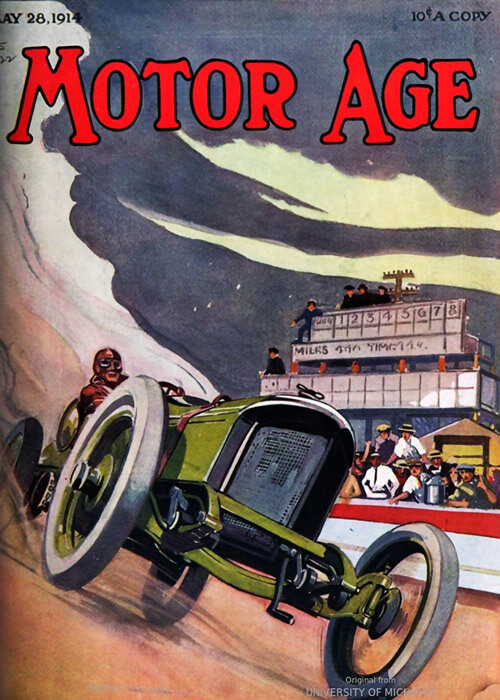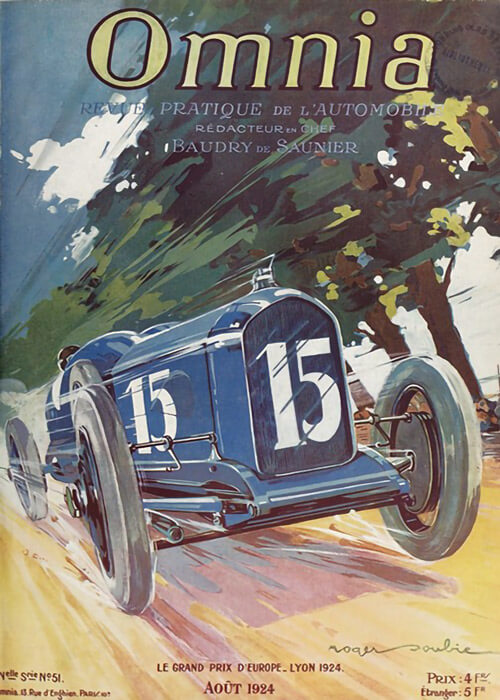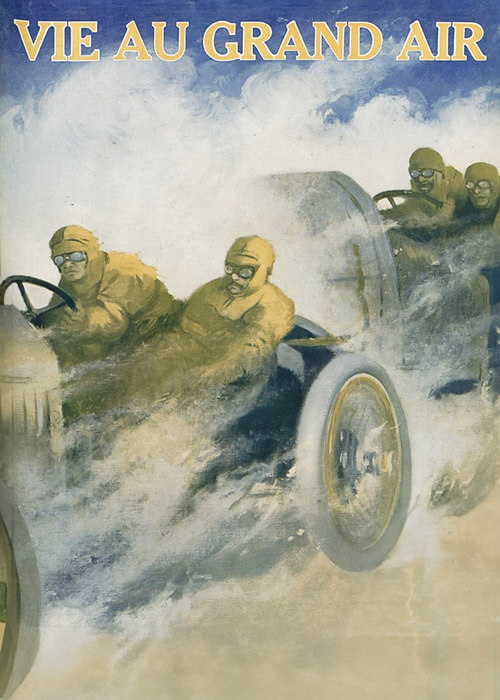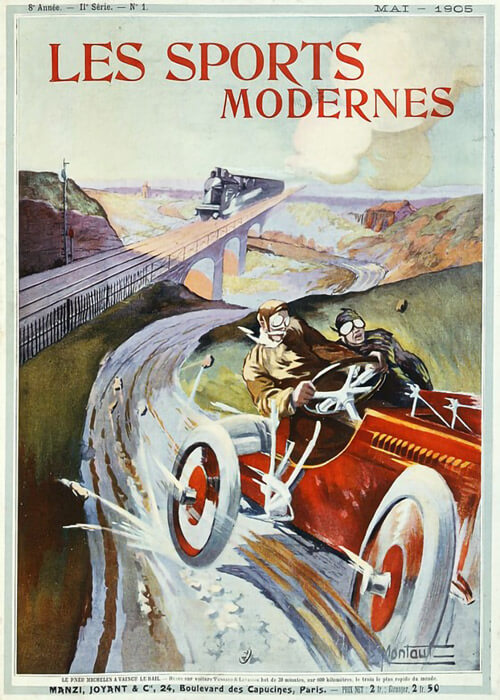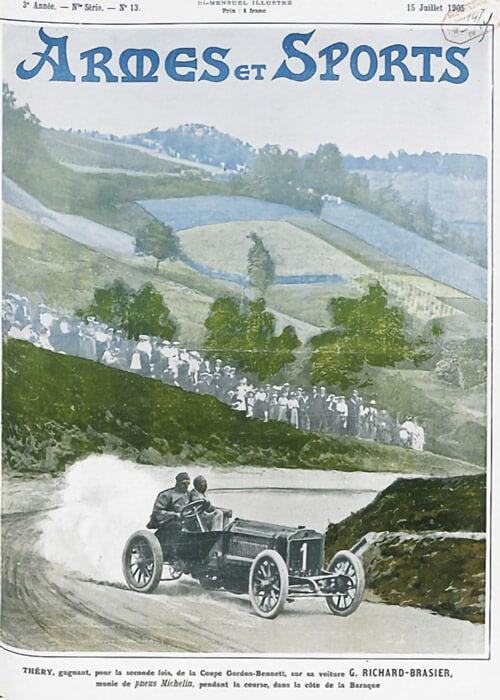

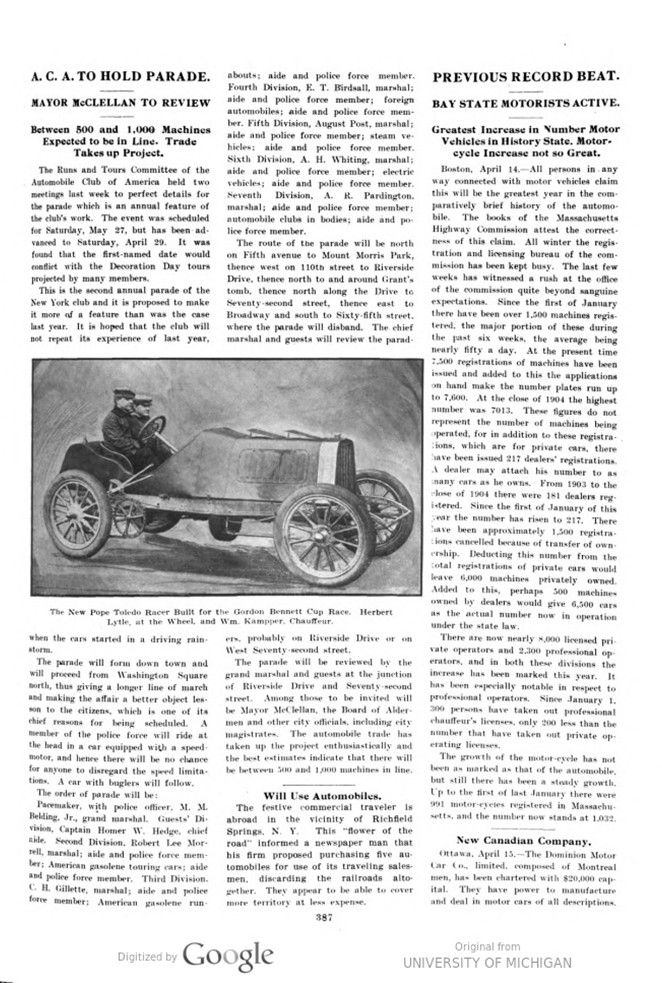
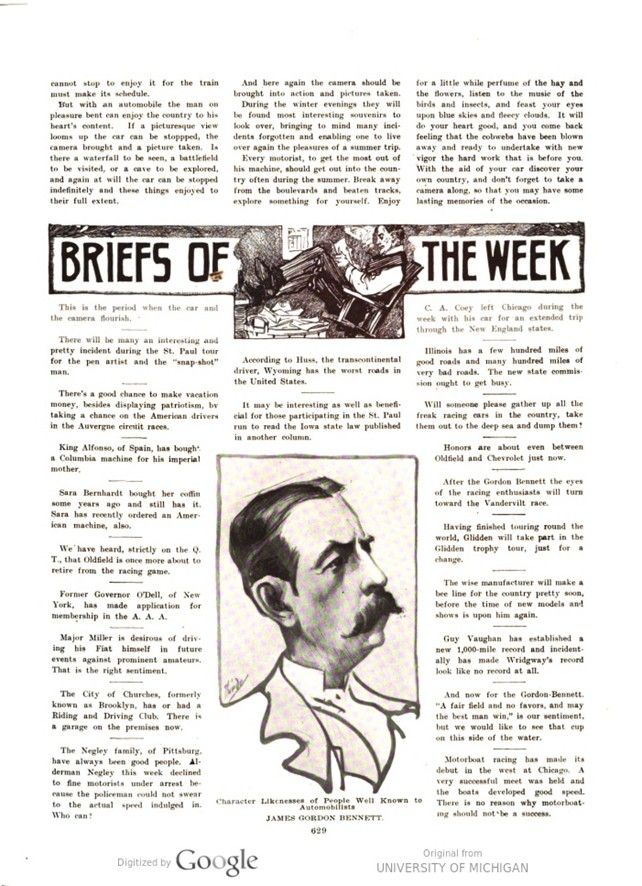
Text and photos with courtesy of hathitrust.org hathitrust.org, compiled by motorracingistory.com
Automobile Review, Vol. 12, No. 16, April 22, 1905
GORDON-BENNETT RACERS READY
After all the discussion, pro and con, and the assertions of French manufacturers that they would not compete in the Gordon-Bennett race, an examination of the entry list, which has just been closed, reveals a sufficient number of entries for the eliminating trials, which will occur June 16, to provide a very satisfactory French team. The last cars to be entered were three Hotchkiss racers, which increases the total number of entries to twenty-four. The full list of cars and the probable drivers who will compete for the privilege of attempting to maintain the supremacy of France in the cup race in July is as follows:
Car. Driver.
1. C. G. V. Girardot
2. Panhard I Heath
3. Panhard II Teste
4. Panhard III H. Farman
5. Gobron Rigolly
6. Richard-Brasier I. Thery
7. Richard-Brasier II. Caillois
8. Richard-Brasier III. Stead
9. Bayard-Clement I. A. Clement
10. Bayard-Clement II. Hanriot
11. Bayard-Clement III. Villemain
12. Darracq I Hemery
13. Darracq II Wagner
14. Darracq III Touloubre
15. Renault I Sisz
16. Renault II Edmond
17. Renault III Bernin
18. Automoto Lapertot
19. De Dietrich I Gabriel
20. De Dietrich II. Rougier
21. De Dietrich III Duray
22. Hotchkiss I A. Fournier
23. Hotchkiss II Le Blon
24. Hotchkiss III Lavergne
We show herewith an illustration of one of the Panhard-Levassor racers. A few important alterations have been made, but otherwise the three cars which are to represent the firm in the eliminating trials are the same as last year. A honeycomb radiator has been substituted for the type formerly used, and a larger cylindrical gasoline tank is fitted between the side members of the pressed steel frame at the extreme rear. The front and rear wheels have, respectively, tires 32¼-in. and 34 5/8 -in. diameter. The transmission to the live rear axle is by means of a multiple-disc main clutch, a change speed gear having four forward speeds with direct drive on high gear and bevel gear shaft. On the high-speed gear, the car is claimed to be capable of about ninety miles an hour. The motor at 1.100 r. p. m. develops 120-horsepower. The cylinders are made of steel and copper, water jacketed. Interchangeable inner and exhaust valves are used and placed on opposite sides of the motor. One of the new features is that the water pressure in the cooling system is made use of to act as an automatic governor controlling the throttle-valve. High tension ignition plugs are fitted horizontally into the inlet valve chambers; they are employed in conjunction with a high-tension magneto that lies beneath the bonnet, in front, on the other side. For lubricating the engine by hand from the dashboard, four independent levers project from the lubricator fitting, thus enabling an ample supply of oil to be at all times forced down to the cylinders as they require it.
In England the eliminating trials are to be held over the Isle of Man course on May 30, and the new racers are rap- idly being pushed to completion. The Napier Company, always early in the game, have their racer already out. The illustration shows Hargreaves, who will probably drive the car in the cup race. at the wheel. Briefly described, the principal features are a pressed nickel steel frame carried on springs mounted outside it and in conjunction with which is fitted a device for reducing rebound on bad stretches of road.
As will be seen, the motor and the radiator – which is of the honeycomb type – are situated behind the front axle, to secure a good distribution of the weight on the four wheels, and there are aluminium windshields, on either side, between the dashboard and the seats. The wheelbase is 8 ft. 10 ins., the track 4 ft. 7½ ins., and the gasoline tank – which forms the back of the driver’s seat – has a sufficient capacity for running 200 miles.
The 80-horsepower 4-cylinder motor is of that Napier type in which separate cast-iron liners are forced into the aluminium jacket casting, and the cylinder heads are cast in pairs with the inlet- valves above the exhaust-valves. The motor is governed on the throttle-valve, subject to the control of a foot accelerator, and the hand-levers regulating the throttle-valve and the time of ignition are placed on the steering-pillar. A high-tension system of ignition is employed, the commutator and distributor for which are chain-driven on the dashboard, and, as an auxiliary to the drip-feed-lubricator for the motor, there is a separate oil-tank coupled up with a semi-rotary pump for the mechanician to force oil into the crank-chamber.
Special care has been taken to render the steering gear satisfactory, and the pillar is set at a considerable angle to enable the driver to sit in a comfortable position. The radiator has a fan fitted immediately behind it, the change-speed-gear provides three forward speeds with a „direct through-drive“ to the back-axle on the high speed. Dunlop tires of the corrugated, non-slipping type are used.
The new Wolseley racers are rated at 90-horsepower, but the 4-cylinder motor is considerably larger than last year, when the car was known as a 96-horsepower machine. Excepting the increase in size of the motor and a few modifications, the racers are the same as used in 1904.
The motor, which has its nickel-steel crankshaft carried in three bearings – with all four cylinders enclosed in one aluminium jacket-casting on the same side of it – is fixed further forward than was the old engine, in order to increase the weight on the steering wheels. In this way, steadier running at very high speeds has been secured, for last year the tendency was for the front wheels not to obtain sufficient traction at the top speed attainable. The bonnet, too, is made flatter than before.
The motor has atmospheric inlet valves, a centrifugal governor acting on a throttle-valve, a hand-controlled throttle-valve, and a foot accelerator for cutting out the governor. The ignition system is of the high-tension type with accumulators; there is a fan immediately behind the radiator; the clutch inside the cast steel flywheel has a leather cone face; and the gearbox, which gives four speeds, is provided with ball- bearings, and is given a three-point suspension in the frame.
Bianchi has been selected to drive one of these cars in the eliminating trials.
Foto captions, page 356-387
Richard Brasier Racing Cars.
John Hargreaves in New Napier Racer Entered for Gordon-Bennett Races.
Wolseley, Gordon Bennett Racer, Bianchi at the Wheel.
Panhard-Levassor Racer that Will Compete for the Honor to Represent France in the Gordon Bennett Cup Race.
The New Pope Toledo Racer Built for the Gordon Bennett Cup Race.
Herbert Lytle, at the Wheel, and Wm. Kampper, Chauffeur.
